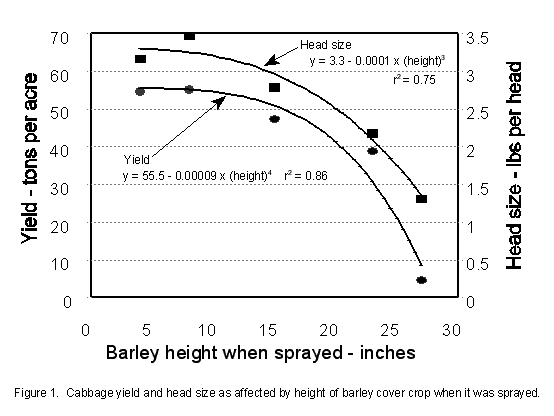
Oakes Irrigation Research
Site
Carrington Research Extension Center * North Dakota State University
P.O. Box 531, Oakes, ND 58474-0531, Voice: (701) 742-2189, FAX: (701)
742-2700, email: rgreenla@ndsuext.nodak.edu
CABBAGE COVER CROP STUDY, 1996
Richard G Greenland
Strong spring winds frequently cause crop damage in North Dakota, especially to crops like cabbage that are planted into a bare, fine seedbed. Planting a cover crop is one possible method to help protect cabbage seedlings. But if left to grow too long, the cover crop could act like a weed, competing with the cabbage for light and nutrients. This study was conducted to determine the best time to kill barley planted as a cover crop in cabbage.
MATERIALS AND METHODS
| Soil: | Hecla sandy loam and Embden sandy loam; pH=6.9; 2.8% organic matter; soil-P was high; soil-K was medium; soil-S was very low. |
| Previous crops: | 1995 - pepper; 1994 - pumpkins; 1993 - field corn. |
| Seedbed preparation: | Disked on April 22. Multiweeded (field cultivated) three times on April 22; once to incorporate fertilizer, twice to incorporate herbicide. |
| Planting: | Direct seeded 'King Cole' cabbage on April 23 with a Stanhay vegetable planter. Seeds were spaced about 7.5 inches apart in 14-inch rows. Plants were later thinned to 15 inches apart (about 26,000 plants/acre). Seeds were placed about 3/4 inch deep into a flat, fine seedbed. |
| Plots: | ach plot was four rows 6 feet wide by 17 ft long. The study had 4 reps. |
| Fertilizer: | On April 17, broadcast 14 lbs N/acre and 70 lbs P2O5/acre as 10-50-0, 16 lbs N/acre and 19 lbs S/acre as 21-0-0-24, and 94 lbs K20/acre as 0-0-60. Sprayed 35 lbs N/acre as 28-0-0 on April 22. |
| Irrigation: | Surface drip irrigation as needed. |
| Pest Control: | Weeds were controlled using Treflan (1 pt/acre applied preplant incorporated on April 22), Lentagran (2 lb/acre on June 7), and by hand weeding. Sevin (1.5 pts/acre on May 15 and May 29) controlled flea beetles. Cabbage was sprayed with Javelin (1 lb/acre on July 15), with Asana (8 oz/acre on July 10, July 25, and Aug 1), and with DiPel (1 lb/acre on Aug 9) to control cabbage looper and cabbage worm. |
| Harvest: | The center 2 rows of each plot were harvested on September 24. |
Return to top of Cabbage Cover Crop Study

RESULTS
The longer the barley is allowed to grow before killing, the better the protection against wind erosion. But if the barley cover crop grows too tall it begins to compete with the cabbage and can reduce yields. As clearly pictured in figure 1, cabbage yield and head size decreased when the barley cover crop was allowed to grow too tall before spraying it with Fusilade to kill it. The yield and head size reductions were not significant until barley exceeded 15 inches tall when killed. This height corresponded to the beginning boot stage of barley. Therefore, we recommend the barley cover crop be allowed to grow to 12 to 15 inches tall (or to just beginning boot stage) before it is sprayed. This may require a higher rate of herbicide or repeat applications to kill the barley.
Return to top of Cabbage Cover Crop Study
Go to Oakes Irrigation Research Site Cover Crop Study page
Go to Oakes Irrigation Research Site 1996 annual report